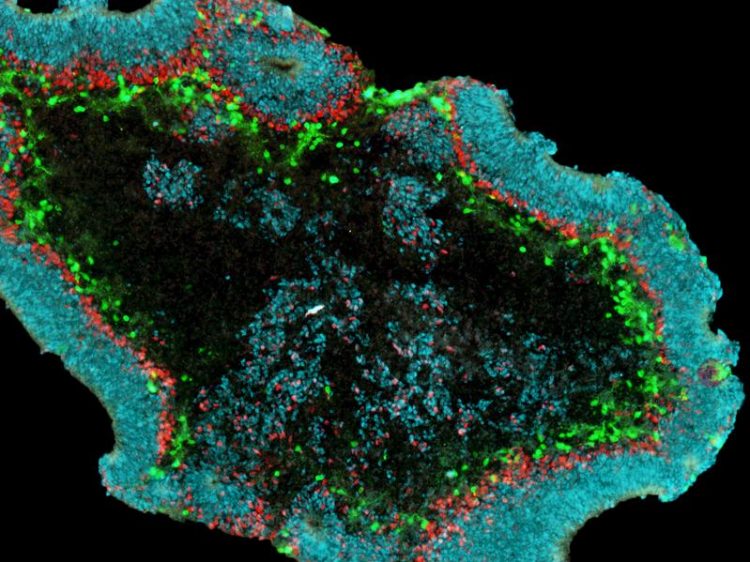Dresden scientists generate model systems for retinal disease research

Retinal Organoid under the microscope © CRTD
Age-related macular degeneration and other diseases of the retina, which result in the progressive loss of neuronal cells in the eyes, are among the most frequent causes of impaired vision and blindness. To date, there are no cures for these diseases and knowledge on their mechanisms is scarce.
“Stem cell based technologies promise new avenues to study these conditions in the laboratory. In particular, we will profit from human cell based disease model systems,” explains Dr. Mike Karl, who leads a research group at the DZNE’s Dresden site and the CRTD.
Thus, Karl and his colleagues have developed a new protocol for the production of organ-like tissues, also called “organoids”, which resemble the retina of mice and humans. These model systems are generated in cell culture from pluripotent stem cells, which have the power to develop into any type of cell in our body.
The Biotechnology Center (BIOTEC) of the TU Dresden including the research group of Dr. Konstantinos Anastassiadis also participated in the project. From studying these retinal organoids the scientists hope to gain new insights on the causes of retinal diseases. “We thereby intend to facilitate the development of potential therapeutic drugs and treatment concepts,” explains Karl.
Compared to previous methods, the Dresden scientists were able to significantly improve the production of 3D retina organoids. Their new approach results in high production efficiency and reproducibility. “Our experimental protocol reliably recapitulates key characteristics of retinal development in vivo. Furthermore, it offers flexibility. We could therefore tailor the organoids to specific questions that we want to study,” comments DZNE researcher Manuela Völkner, lead author of the current publication. In particular, the researchers succeeded to raise the production of cone photoreceptor neurons. These sensory cells are essential for our color vision and high visual acuity, especially for reading.
“We now have the means to produce larger amounts of these precious cells, which is a premise for certain studies. This includes basic research as well as studies in regenerative medicine,” explains Karl. “For instance, several labs are pursuing the idea to restore vision due to cell loss by retinal cell transplantation. There is certainly a long way to go. But our model systems might help to develop such therapeutic strategies.”
These most recent successes of Dresden researchers once again demonstrate the potential that is harnessed through the close collaboration of several disciplines at the life science campus in Dresden-Johannstadt.
Scientific publication:
„Retinal Organoids from Pluripotent Stem Cells Efficiently Recapitulate Retinogenesis“, Manuela Völkner, Marlen Zschätzsch, Maria Rostovskaya, Rupert W. Overall, Volker Busskamp, Konstantinos Anastassiadis, Mike O. Karl, Stem Cell Reports,
http://dx.doi.org/10.1016/j.stemcr.2016.03.001
Press Contact:
Franziska Clauß, M.A.
CRTD Press Officer
Phone: +49 351 458 82065, e-Mail: franziska.clauss@crt-dresden.de
Dr. Marcus Neitzert
DZNE Press and Public Relations
Phone: +49 228 43302271, e-Mail: marcus.neitzert@dzne.de
Founded in 2006, the DFG Research Center for Regenerative Therapies Dresden (CRTD), Cluster of Excellence at the TU Dresden has passed the third phase of the Excellence Initiative which aims at promoting top-level research and improving the quality of German universities and research institutions. The goal of the CRTD is to explore the body's self-healing potential and to develop completely new, regenerative therapies for hitherto incurable diseases. The key areas of research include haematology and immunology, diabetes, neurodegenerative diseases and bone regeneration. At the moment, eight professors and ten group leaders are working at the CRTD – integrated into an interdisciplinary network of 87 members at seven different institutions within Dresden. In addition, 21 partners from industry are supporting the network. The synergies in the network allow for a fast translation of results from basic research to clinical applications.
www.crt-dresden.de
The German Center for Neurodegenerative Diseases (DZNE) investigates the causes of diseases of the nervous system and develops strategies for prevention, treatment and care. It is an institution within the Helmholtz Association of German Research Centers with nine sites across Germany (Berlin, Bonn, Dresden, Göttingen, Magdeburg, Munich, Rostock/Greifswald, Tübingen and Witten). The DZNE cooperates closely with universities, their clinics and other research facilities. Cooperation partners in Dresden are the Technische Universität Dresden and the Universitätsklinikum Carl Gustav Carus.
Enclosures:
Portrait: Dr. Mike O. Karl © CRTD
Microscope image: Retinal Organoid under the microscope: The following cell types are labeled in a tissue section: Cyan = photoreceptors (marker CRX), red = bipolar neurons & glia cells (marker VSX2), green = amacrine neurons (marker hPAX6GFP) © CRTD
Infographic: Production of retinal organoids from pluripotent stem cells © CRTD based on Stem Cell Reports)
Media Contact
All latest news from the category: Life Sciences and Chemistry
Articles and reports from the Life Sciences and chemistry area deal with applied and basic research into modern biology, chemistry and human medicine.
Valuable information can be found on a range of life sciences fields including bacteriology, biochemistry, bionics, bioinformatics, biophysics, biotechnology, genetics, geobotany, human biology, marine biology, microbiology, molecular biology, cellular biology, zoology, bioinorganic chemistry, microchemistry and environmental chemistry.
Newest articles

NASA: Mystery of life’s handedness deepens
The mystery of why life uses molecules with specific orientations has deepened with a NASA-funded discovery that RNA — a key molecule thought to have potentially held the instructions for…

What are the effects of historic lithium mining on water quality?
Study reveals low levels of common contaminants but high levels of other elements in waters associated with an abandoned lithium mine. Lithium ore and mining waste from a historic lithium…

Quantum-inspired design boosts efficiency of heat-to-electricity conversion
Rice engineers take unconventional route to improving thermophotovoltaic systems. Researchers at Rice University have found a new way to improve a key element of thermophotovoltaic (TPV) systems, which convert heat…



